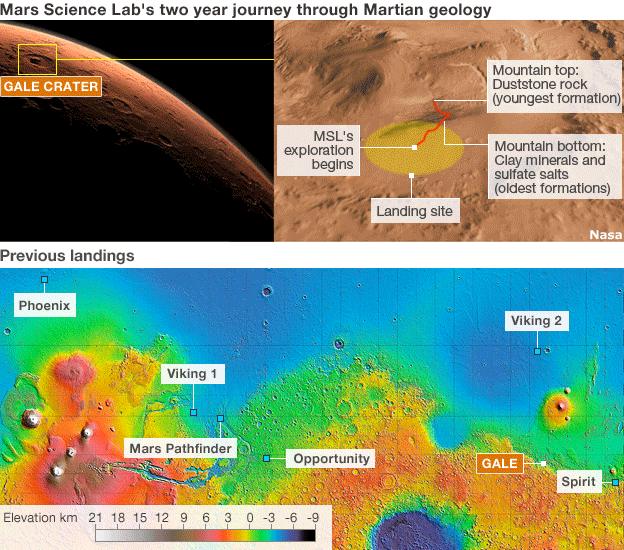Nasa may miss Curiosity Mars rover's landing signal
- Published
Mars programme director Doug McCuistion: "Is it crazy? Well, not so much" (Courtesy of Nasa)
Nasa might not be able to follow the progress of its big Mars rover all the way to the surface when it attempts to land on the planet on 6 August (GMT).
The Curiosity vehicle is aiming for a deep depression known as Gale Crater.
The US space agency will be tracking the descent with satellites, but its prime craft for the task may not now be in the correct place in the sky.
Engineers have been tackling a fault on the Odyssey satellite and it is no longer in the best observational orbit.
Unless it can be moved back in the next three weeks, Nasa will lose signal to the rover just as it is about to touch down.
This will not affect the outcome of the landing because Curiosity's descent manoeuvres are all performed autonomously, but it will give rise to some high anxiety as everyone awaits confirmation that the $2.5bn mission is safely on the surface.
"Odyssey right now looks like it may not be in the same spot that we'd expected it to be," said Doug McCuistion, the director of Nasa's Mars exploration programme.
"There may be some changes in real-time communication. We'll let you know as this develops; we still have more work to do. But keep in mind, there is no risk to [Curiosity] landing. It does not have an effect on that."
High risk
The 900kg robot's entry, descent and landing (EDL) will be the most dangerous aspect of the entire mission.
The rover, in its protective capsule, will hit the top of the Martian atmosphere at 20,000km/h (13,000mph) and attempt to slow to just one metre per second to execute a soft touchdown.
This rapid deceleration must be achieved in about seven minutes or Curiosity will smash into the ground.
Engineers have built a complex EDL system that includes a supersonic parachute and a rocket-powered crane. Everything must work on cue and in sequence.
It was expected that the Odyssey orbiter would track the whole descent, relaying UHF signals from the rover right up to the landing and for a few minutes beyond.
But the spacecraft recently experienced a reaction wheel failure.
This device is used to manage the satellite's orientation and momentum in space, and because engineers have been investigating the issue they have not as yet moved Odyssey back into the correct orbit to see the full landing sequence - and they may not do so.
This would leave Nasa blind for the final, nail-biting two minutes of the landing operation.
Transmission delay
Antennas on Earth will be following the descent but they will lose contact as Curiosity hurtles into Gale, one of the deepest holes on Mars. The steep crater walls will block all direct radio transmission to the home planet not long after the supersonic parachute is opened.
The Europeans' Mars Express satellite will be watching, but its position in the sky means it will have a similar problem to Earth antennas.
Nasa's other satellite - the Mars Reconnaissance Orbiter (MRO) - will see the whole landing sequence but it only has a "store and forward" capability, which puts a significant delay in its data return time to Earth.
MRO's information will not be available to engineers on Earth for three to four hours after the rover has placed itself on the surface.
As things stand, Nasa could be waiting on Odyssey to make a late pass of the landing site, perhaps five to 10 minutes after the rover's planned touchdown.
This is projected to be 22:31 PDT 5 August; 01:31 EDT, 05:31 GMT, 06:31 BST 6 August.
This is "Earth receive" time - the time a signal sent from Mars is received on Earth. The 250 million km between Mars and Earth on 5/6 August mean a radio transmission takes just under 14 minutes to pass between the two planets.
"If Odyssey is not able to be moved and it still remains late, that means it will fly over [Curiosity] after the spacecraft has landed, and we presumably will [then] be able to see transmissions from it. It would be somewhere between 22:35 and 22:40 PDT," explained Pete Theisinger, the rover project manager at Nasa's Jet Propulsion Laboratory in Pasadena, California.
Curiosity - also known as the Mars Science laboratory (MSL) - is the most sophisticated space vehicle ever built to touch the surface of another world.
Assuming the robot lands safely, it will spend 98 (Earth) weeks scouring Martian soils and rocks for any signs that current or past environments on the planet could have supported microbial life.
Gale Crater was chosen as the landing site because satellite pictures had spied sediments in the depression which looked as though they were laid down in the presence of abundant water.
MSL-Curiosity is equipped with 10 advanced instruments. It also has a plutonium battery and so should have ample power to keep rolling for more than a decade.
It is likely the mechanisms on the rover will wear out long before its energy supply.

MSL-Curiosity will try to land at the base of Gale Crater and then climb the mountain at its centre
Jonathan.Amos-INTERNET@bbc.co.uk and follow me on <link> <caption>Twitter</caption> <url href="https://twitter.com/#!/BBCAmos" platform="highweb"/> </link>
- Published12 June 2012
- Published25 May 2012
- Published15 March 2012
- Published6 March 2012
- Published12 January 2012
- Published26 November 2011
- Published24 November 2011